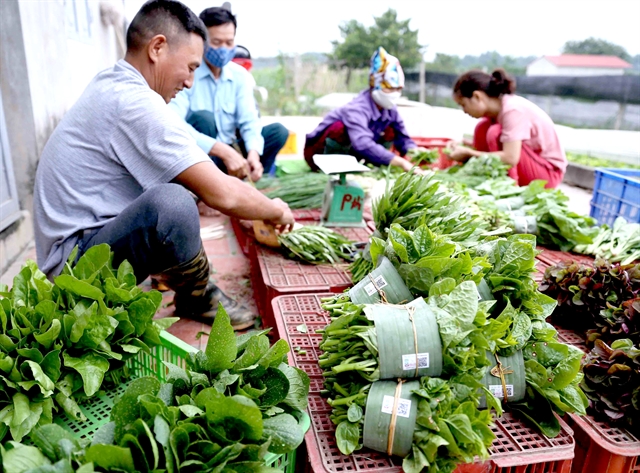 Opinion
Opinion

Head of the Cultivation and Plant Protection Division under Hà Nội’s Department of Agriculture and Rural Development Nguyễn Mạnh Phương speaks to Hà Nội Mới (New Hà Nội) newspaper about the city’s safe vegetable production

|
| Organic vegetables grown in Thanh Xuân organic vegetable co-operative in Hà Nội's Sóc Sơn District are prepared to supply stores. — VNA/VNS Photo Vũ Sinh |
Head of the Cultivation and Plant Protection Division under Hà Nội’s Department of Agriculture and Rural Development Nguyễn Mạnh Phương speaks to Hà Nội Mới (New Hà Nội) newspaper about the city’s safe vegetable production
Can you tell us about safe vegetable production in Hà Nội?
Currently, Hà Nội’s total cultivation area is 12,000ha across its 22 districts, producing nearly 700,000 tonnes per year which meets 70 per cent of the city’s demand.
Of the total cultivation area, the safe vegetable growing area is 5,044ha including 521.6ha applying VietGAP and 50ha of organic vegetables. Nearly 400,000 tonnes of safe vegetables are produced in the city yearly, generating revenue of VNĐ1 billion per hectare per year.
There are 151 specialised zones growing vegetable in the city with a total area of more than 6,640ha. The cultivation division and local authorities have worked together to open training classes providing farmers with a better understanding of safe vegetable production and called on them to meet requirements in safe vegetable production. Particularly, growers minimise the use of plant protection products in safe vegetable production under the Integrated Pest Management (IPM) programme.
In early July, Hà Nội approved the plan on the expansion of production and consumption of safe vegetable in the city from 2021 to 2025. Can you give us some details of the plan?
Under Plan No 137/KH-UBND, from 2021 to 2025, besides more that 5,000ha of vegetable area certified for food safety, Hà Nội will expand 3,000-4,000ha of safe vegetable which is expected to help generate VNĐ300-500 million (US$13,100-21,800) per hectare per year, with winter crops expected to gain VNĐ120 million ($5,200) per hectare.
In addition, the city hopes to keep pesticide residue under the regulated levels in 90 per cent of the city’s safe vegetable areas.
The city also plans to develop more 30-40 safe vegetable supply chains, ensuring all the products’ origins can be traceable.
The city will also strengthen activities in research, training and technological transfer on safe vegetable production.
What does the cultivation department plan to do to support the development of safe vegetable growing areas in the city?
First, we will organise about 150-200 training classes yearly for about 5,250 farmers on the IPM programme. New techniques on pest prevention and control will be tried at about 100 locations.
In the near future, about 3,600ha of the vegetable area needs to be re-certified and soil/water samples at cultivation areas must be tested again. The cultivation department will concentrate on certification granting and tightening food safety inspections.
We will test about 1,000 vegetable samples yearly to evaluate food safety levels and the farmers’ abilities in following pesticide management requirements and technological applications.
The department will also work with communications agencies and mass media in the city to promote the production and consumption of safe vegetables as well as regulations on pesticide products and food safety.
To ensure sustainable development of safe vegetable production, the cultivation department will also work with agencies to tighten control of agricultural materials at all stages like production, trade and use to timely detect violations.
In the long-term, the city’s agriculture sector will concentrate on developing safe vegetable production-consumption chains enclosed with origin traceability to household producers. Farming products will be registered for their own trademark, especially those produced with high-tech applications, promoting the city’s safe vegetable to more and more consumers. — VNS




